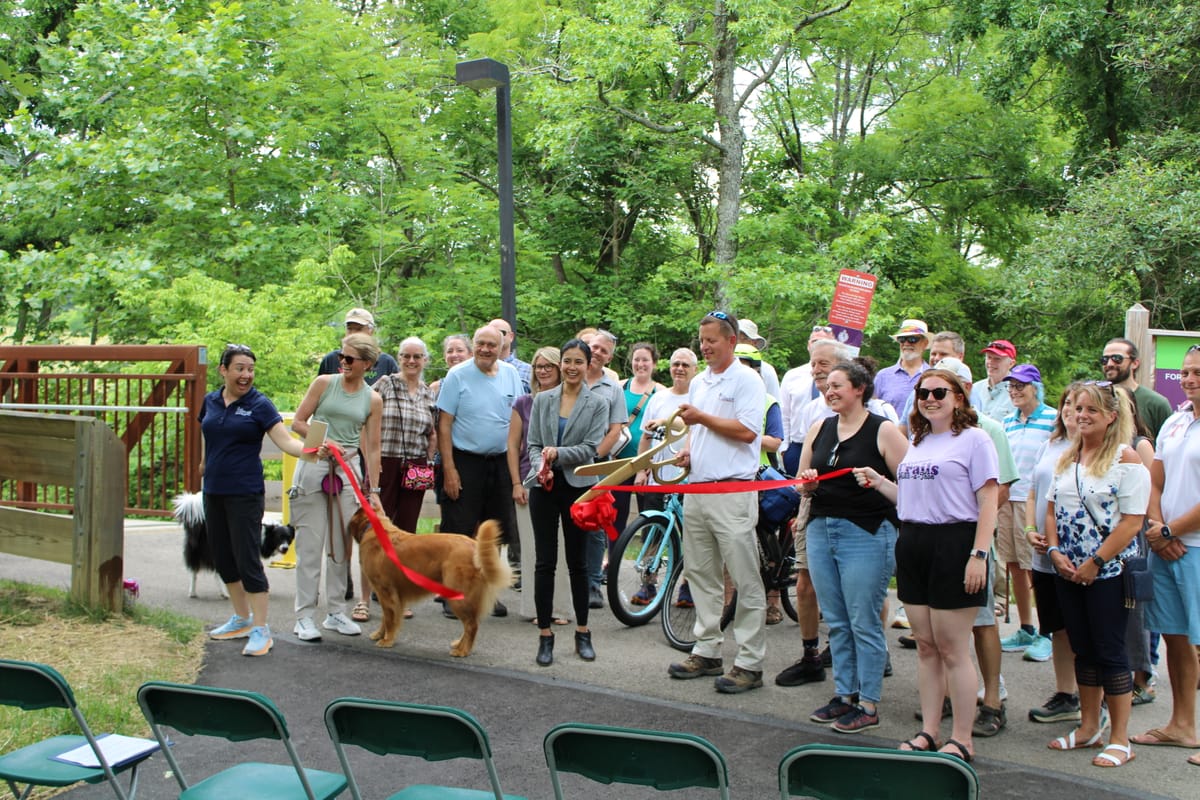Oxford celebrates completion of newest section of trails
Phase Three of the Oxford Area Trail System (OATS) is officially complete, linking Peffer Park to Talawanda High School with a paved multimodal path.

Phase Three of the Oxford Area Trail System (OATS) is officially complete, linking Peffer Park to Talawanda High School with a paved multimodal path.
The city celebrated the newest phase's completion with a ribbon-cutting ceremony on June 20. Roughly three dozen people attended, though few participated in a hike of the trail after the ceremony due to high temperatures.
Jessica Greene, assistant city manager, led the ceremony. With the newest connection, she said high school students who live on the north end of Oxford now have a safe way to bike to school each day. Talawanda does not currently offer busing to high schoolers.
Work on Phase Four of the OATS, which will connect Talawanda Middle School to Oxford Community Park, has already begun. Phase Five, which will connect the middle school to the high school, is currently in the planning phase.
"We're going to keep going," Greene said at the ceremony, "and we're going to see what we can do for the town."
A trail system decades in the making

Oxford residents first began talking about a multimodal trail more than 30 years ago, and the idea was added to the city's 2008 Comprehensive Plan. Greene didn't get involved in discussions until 2012 when she worked at Enjoy Oxford, but even then she says it didn't quite feel real.
"A lot of people thought it couldn't be done," Greene said. "There wasn't money. It was too big of a project. It was too pie in the sky. I remember going to city council and saying, 'If money is the problem, and I find your money, can we do this?'"
In 2014, Greene found the money with the help of community development director Sam Perry. The city applied to a grant from Clean Ohio and received $500,000 for Phase One of the trails, paid out in 2015. After raising more than $200,000 in funding from the community, the city was ready to begin construction.
Phase One opened in 2017, connecting the Black Covered Bridge to Leonard G. Howell Park. Building on the momentum of the first phase's success, Greene said the next step was passing a levy to ensure financial support.
In 2018, the city put a 10-year levy up for a vote, asking for $325 per $100,000 in property valuations during that year's primary. The measure passed with nearly 70% in favor, and the city prepared for the next phase.
Edna Southard, a former city councilor who served when the levy was passed, attended the opening for Phase Three. She said the people who voted for the levy made the trails possible, and she now uses them almost every day.
"I like to walk an hour a day," Southard said. "I have a group of women on Sunday mornings that hikes."
To date, the city has raised more than $6.4 million in grants for phases one through five, in addition to nearly $6.8 million from the levy, $700,000 from Miami University and $208,000 in other donations for Phase One.
With Phase Three done, city looks to the future

The city is celebrating the completion of Phase Three, but the trails are far from complete. Greene said Phase Four could open as soon as September. The next goal after that is connecting the high school to the middle school, but the long-term vision is a loop around the entire city.
While the city successfully passed a levy for funding and has received more than $6.4 million in funding for phases one through five, the trails have faced some pushback.
In 2021, the city officially paused planning on a northwest segment that would stretch across Route 27 from Contreras Road all the way to the Black Covered Bridge. The move came after several private homeowners threatened legal action against the city because the proposed path would have cut through their property on Hester Road. The homeowners, who formed a coalition called Team Trail, suggested a trail that ran to Hueston Woods or focused on the Uptown area instead to avoid using land on private property.
Now, Greene said the city has had time to debate the best path forward and is preparing for wider conversations to work out a plan for the northwest corridor to proceed.
"I actually do think that pausing was the right thing to do," Greene said. "... We've had a few years to reflect on that, and we do plan to dust it off and bring it back forward for discussions in public meetings that will be posted."
In the future, when the current OATS phases are complete, Greene said the plan to connect to Hueston Woods may come back, though it's still just a dream for now.
For Mason Wyss, a resident of Oxford for the past two years, a Hueston Woods connection would lead him to use the trails more. He attended the Phase Three ribbon-cutting ceremony to support environmental efforts that decrease reliance on cars and said he especially appreciates the connections to natural areas.
"I'm a big supporter of decarbonization and moving towards a green future where we can not destroy the planet and the biosphere," Wyss said. "I think actions like these are a good step towards a future where we're not so heavily dependent on carbon emissions for transportation."




